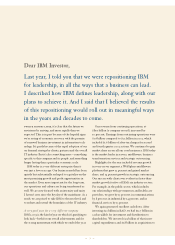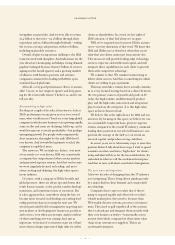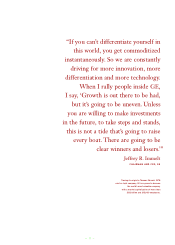IBM 2003 Annual Report Download - page 9
Download and view the complete annual report
Please find page 9 of the 2003 IBM annual report below. You can navigate through the pages in the report by either clicking on the pages listed below, or by using the keyword search tool below to find specific information within the annual report.
7
Becoming one is dauntingly hard to pull off. It
requires both the end-to-end integration of the tech-
nology—which niche product vendors simply cannot
do—and the integration of technology with business
processes. This in turn requires deep business knowl-
edge and industry expertise that few traditional
technology companies have, and significant technical
knowledge and research strengths that few consulting
firms possess.
Integration is also an emerging force in core tech-
nology and computing architectures. To cite one
example, advances in semiconductor devices have
been largely propelled by increasing the clock speed
of the microprocessor chip; this is like revving up the
RPM of a car engine. But while advances in raw speed
are continuing apace, they are no longer enough to
increase chip and overall system performance. For one
thing, chips have become so densely packed with
transistors that they produce more heat than can be
cost-effectively dissipated.
The solution is integration—putting multiple, often
less-than-top-speed processors on the same chip, along
with additional functions like fast memory and high-
performance input/output. This is the approach IBM
engineers have taken in developing our Blue Gene
supercomputer. Integration of this sophistication is
beyond the reach of most chip and systems companies.
It requires expertise not just in semiconductors but
in advanced systems architecture, custom logic
design, operating systems and software tools. This
is the kind of expertise that IBM has built up over
decades, and it is not easily replicated. And that’s
why technology leaders like Sony, Cisco, Apple and
QUALCOMM have partnered with IBM for advanced
technology—and why last year Microsoft licensed
IBM’s microprocessor technology for use in its
next-generation Xbox game console.
Bulking up in on demand
Many IT companies will struggle with this world that
is dawning—with the need to choose between open
and proprietary, between serving consumers and
enterprises, between redistributing other people’s
intellectual capital and innovating. This is not about
making pronouncements or promises. A company
cannot be all things to every client, every partner
and every investor.
For our part, we’ve decided. The two parallel trajec-
tories of integration—in client demand and in what the
technology requires—play directly to IBM’s historic
strengths. However, even with everything IBM brought
to this table, we needed more. That’s why we’ve made
acquisitions such as PricewaterhouseCoopers
Consulting (PwCC), Rational software and 19 other
companies in the past two years. And it’s why we reset
our priorities in R&D to develop more technologies
and services specifically for client needs in the
on demand era.
On demand integration is also why we’ve placed a
huge bet on standards, from the Internet protocols
and Linux to grid computing and Web services.
Without open technical interfaces and agreed-upon
standards, even integration within a single enterprise
would remain a gargantuan task. And forget about
integration with the other companies, business
processes, applications, pervasive computing devices,
laws, regulations, customs and cultures that make up
the ever-more-global marketplace of the 21st century.
An IT company’s position on open standards—not
just its rhetoric, but its actions—is a clear indicator
of whether it faces forward or backward, is serving
the needs of clients or protecting its market position.
In addition to the opportunities I’ve described, our
move into on demand has opened up some very large
businesses beyond the frontiers of the traditional IT
industry—opportunities that remain out of reach for
most of our competitors.
One promising example is Business Transformation
Outsourcing (BTO), which was not even part of the
industry lexicon 18 months ago. In BTO engagements,
IBM becomes responsible for transforming—and
actually providing—a client’s business process in
areas such as human resources, procurement, customer
care, and finance and administration. Thanks to the
acquisition of PwCC and the formation of IBM
Business Consulting Services, we generated nearly
$3 billion in BTO signings during the fourth quarter of
2003 alone. To give a rough idea of the potential here,
the current size of businesses’ outsourced spending on
sales, marketing, logistics, finance, HR and all other
administrative processes is about $1 trillion a year. Of
that, there is an opportunity in excess of $1oo billion
in the BTO areas we are pursuing. We are committed
to extend our leadership position in BTO in 2004.
CHAIRMAN’S LETTER






















